ITO Meta-Absorber-Loaded Conformal UHF Monopole Antenna with Wide-Angel RCS Reduction
Abstract
1. Introduction
2. Antenna Design Procedure
2.1. The Design and Scattering Characteristics of the UHF Monopole Antenna
2.2. The Design of the Squared Ring Absorber
2.3. The Design of the Taper Absorber
3. Fabrication and Measurement
4. Conclusions
Author Contributions
Funding
Data Availability Statement
Conflicts of Interest
References
- Svanda, M.; Polivka, M. Matching technique for an on-body low-profile coupled-patches UHF RFID tag and for sensor antennas. IEEE Trans. Antennas Propag. 2015, 63, 2295–2301. [Google Scholar]
- He, P.; Fan, K.; Luo, G. A Wideband Dual Circularly Polarized Antenna Based on Septum Polarizer for Satellite Communications. In Proceedings of the 2022 International Conference on Microwave and Millimeter Wave Technology (ICMMT), Harbin, China, 12–15 August 2022. [Google Scholar]
- Qin, D.; Sun, B.; Zhang, R. VHF/UHF ultrawideband slim monopole antenna with parasitic loadings. IEEE Antennas Wirel. Propag. Lett. 2022, 21, 2050–2054. [Google Scholar]
- Sun, D.M.; Hao, Z.C.; Gang, H.J.; Ding, C.Y.; Liu, W.Y.; Miao, Z.W. A planar UHF-band ultrawideband modular antenna array with tapered probes feed. IEEE Trans. Antennas Propag. 2024, 72, 1483–1496. [Google Scholar]
- Dang, Q.H.; Chen, S.J.; Nguyen-Trong, N.; Fumeaux, C. Dual-band frequency-reconfigurable wearable antennas for UHF radio band applications. IEEE Trans. Antennas Propag. 2023, 72, 243–255. [Google Scholar]
- Zhang, X.; Li, H.X.; Chung, H.S.H. UHF RFID antenna sensor system using optimal power-oriented setup-independent technique. IEEE Trans. Antennas Propag. 2023, 71, 8639–8647. [Google Scholar] [CrossRef]
- Motroni, A.; Pino, M.R.; Cecchi, G.; Nepa, P. A near-field focused array antenna empowered by deep learning for UHF-RFID smart gates. IEEE Trans. Antennas Propag. 2023, 71, 7946–7957. [Google Scholar]
- Sun, D.M.; Hao, Z.C.; Ding, C.Y.; Liu, R.J.; Guo, Z.J.; Yin, H.Y. A low-profile ultra-wideband and wide-scanning phased array for UHF applications. IEEE Trans. Antennas Propag. 2022, 71, 473–486. [Google Scholar]
- Xu, R.; Shen, Z. Wideband ferrite-loaded bow-tie antenna of extremely low-profile. IEEE Trans. Antennas Propag. 2022, 70, 11401–11409. [Google Scholar]
- Dikmen, C.M.; Cimen, S.; Cakir, G. Planar octagonal-shaped UWB antenna with reduced radar cross section. IEEE Trans. Antennas Propag. 2014, 62, 2946–2953. [Google Scholar]
- Song, J.; Huang, C.; Yang, J.; Zhang, X.; Peng, J.; Luo, X. Broadband and tunable radar absorber based on graphene capacitor integrated with resistive frequency-selective surface. IEEE Trans. Antennas Propag. 2019, 68, 2446–2450. [Google Scholar] [CrossRef]
- Tang, B.; Zhu, Y.; Zhou, X.; Huang, L.; Lang, X. Wide-angle polarization-independent broadband absorbers based on concentric multisplit ring arrays. IEEE Photonics J. 2017, 9, 1–7. [Google Scholar] [CrossRef]
- Al-Nuaimi, M.K.T.; Whittow, W.G.; Huang, G.L.; Chen, R.S.; Wong, S.W. Wideband radar-cross-section reduction using parabolic phased metasurfaces. IEEE Antennas Wirel. Propag. Lett. 2023, 22, 1547–1551. [Google Scholar] [CrossRef]
- Qu, M.; Zhang, C.; Su, J.; Liu, J.; Li, Z. Extremely wideband and omnidirectional RCS reduction for wide-angle oblique incidence. IEEE Trans. Antennas Propag. 2022, 70, 7288–7293. [Google Scholar] [CrossRef]
- Su, J.; Lu, Y.; Liu, J.; Yang, Y.L.; Li, Z.; Song, J. A novel checkerboard metasurface based on optimized multielement phase cancellation for superwideband RCS reduction. IEEE Trans. Antennas Propag. 2018, 66, 7091–7099. [Google Scholar] [CrossRef]
- Ghosh, S.; Bhattacharyya, S.; Chaurasiya, D.; Srivastava, K.V. Polarisation-insensitive and wide-angle multi-layer metamaterial absorber with variable bandwidths. Electron. Lett. 2015, 51, 1050–1052. [Google Scholar] [CrossRef]
- Singh, A.K.; Abegaonkar, M.P.; Koul, S.K. Dual- and triple-band polarization insensitive ultrathin conformal metamaterial absorbers with wide angular stability. IEEE Trans. Electromagn. Compat. 2018, 61, 878–886. [Google Scholar] [CrossRef]
- Chen, Q.; Guo, M.; Sang, D.; Sun, Z.; Fu, Y. RCS reduction of patch array antenna using anisotropic resistive metasurface. IEEE Antennas Wirel. Propag. Lett. 2019, 18, 1223–1227. [Google Scholar] [CrossRef]
- Tian, Y.; Gao, H.; Yao, W.; Huang, X.; Peng, F.; Yu, L. Out-of-band RCS reduction of HF/VHF whip antenna using curved AMC structures. IEEE Trans. Antennas Propag. 2022, 70, 10086–10094. [Google Scholar] [CrossRef]
- Costa, F.; Monorchio, A.; Manara, G. Analysis and design of ultra thin electromagnetic absorbers comprising resistively loaded high impedance surfaces. IEEE Trans. Antennas Propag. 2010, 58, 1551–1558. [Google Scholar] [CrossRef]
- Zhang, T.; Pang, X.; Zhang, H.; Zheng, Q. Ultrabroadband RCS reduction and gain enhancement of patch antennas by phase gradient metasurfaces. IEEE Antennas Wirel. Propag. Lett. 2022, 22, 665–669. [Google Scholar] [CrossRef]
- Yao, W.; Gao, H.; Tian, Y.; Wu, J.; Guo, L.; Huang, X. Wideband low-RCS linear polarized array based on miniaturized polarization conversion metasurface. IEEE Trans. Antennas Propag. 2023, 71, 5663–5674. [Google Scholar]
- Liu, Y.; Jia, Y.; Zhang, W.; Li, F. Wideband RCS reduction of a slot array antenna using a hybrid metasurface. IEEE Trans. Antennas Propag. 2020, 68, 3644–3652. [Google Scholar] [CrossRef]

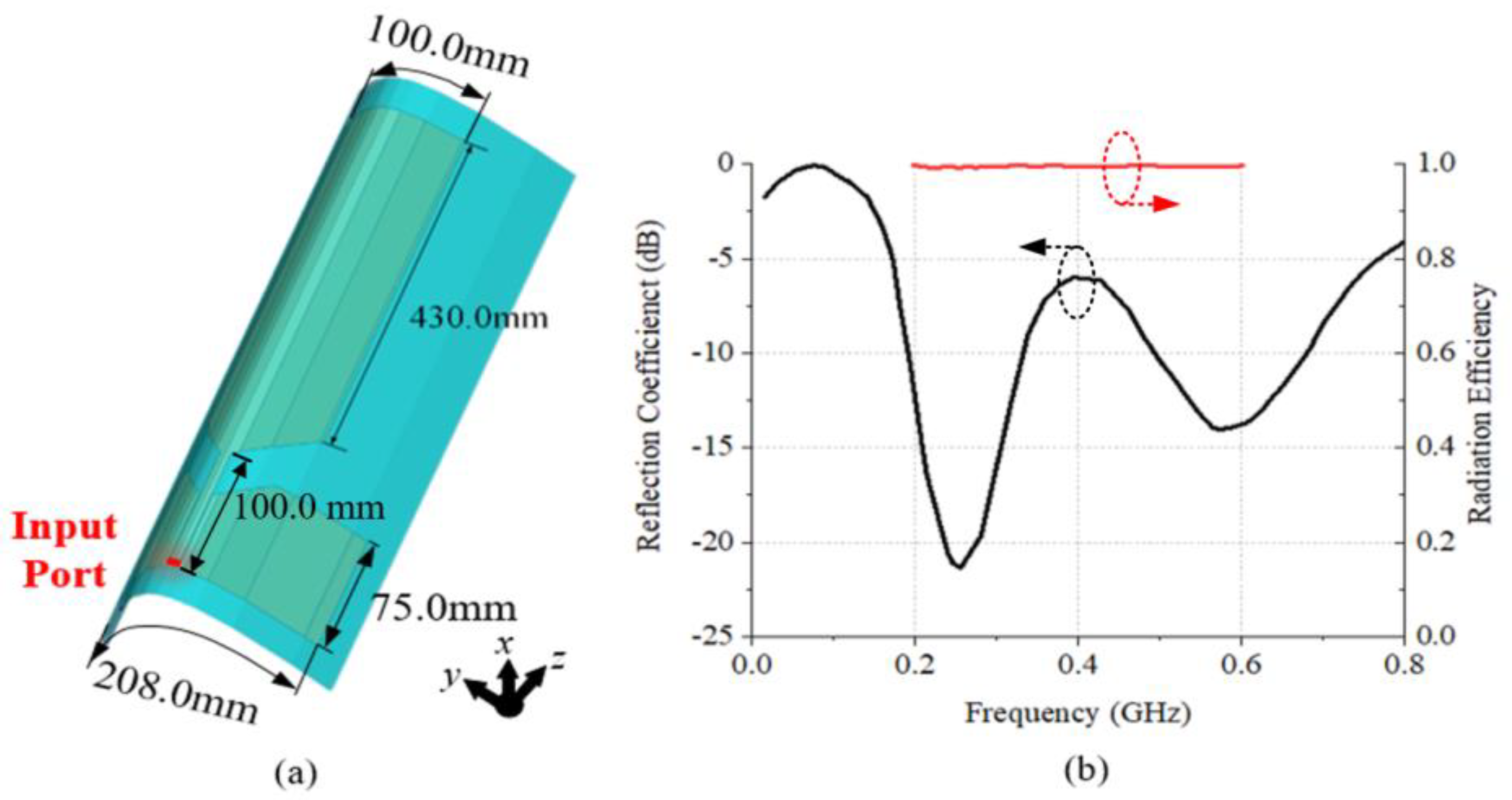
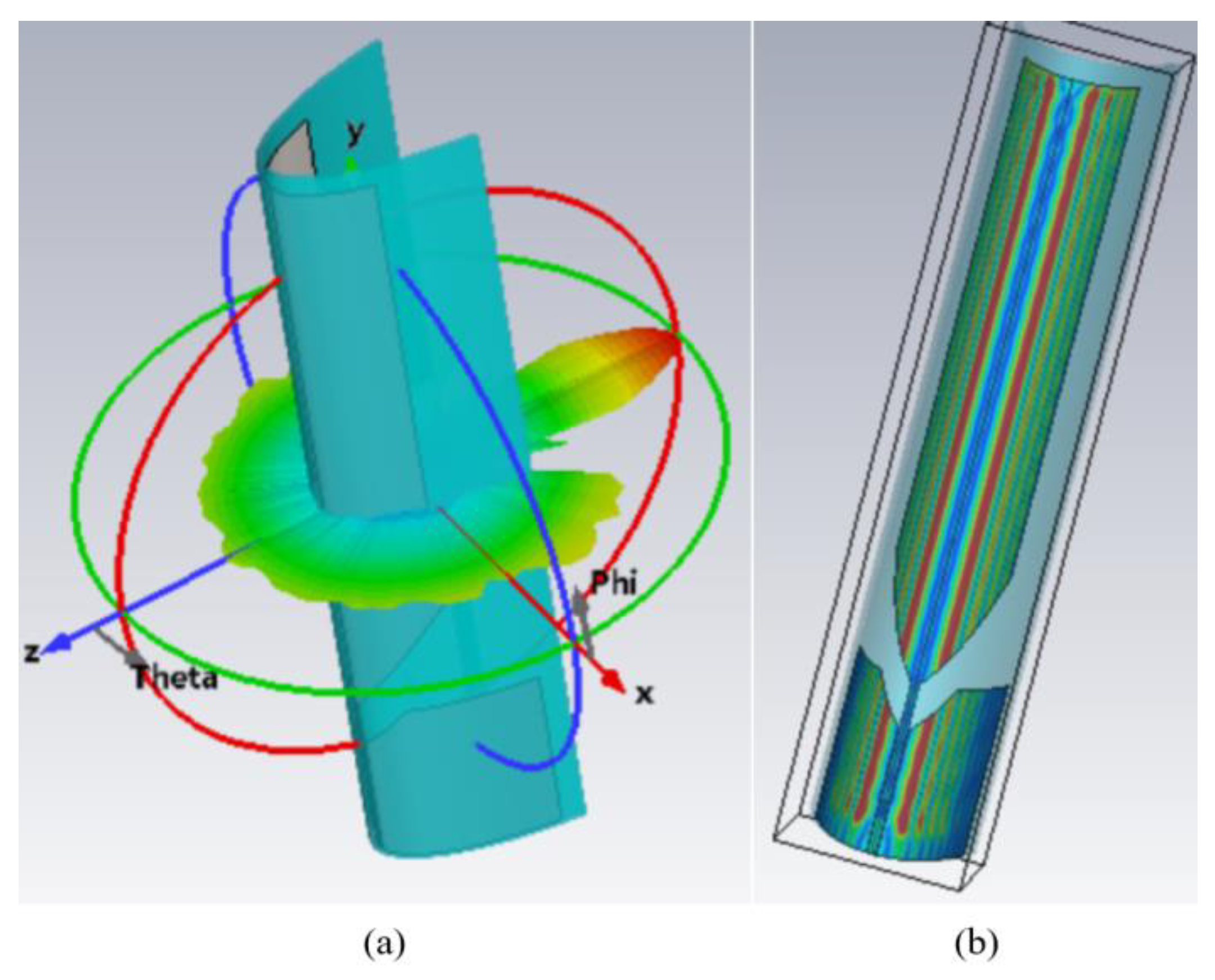
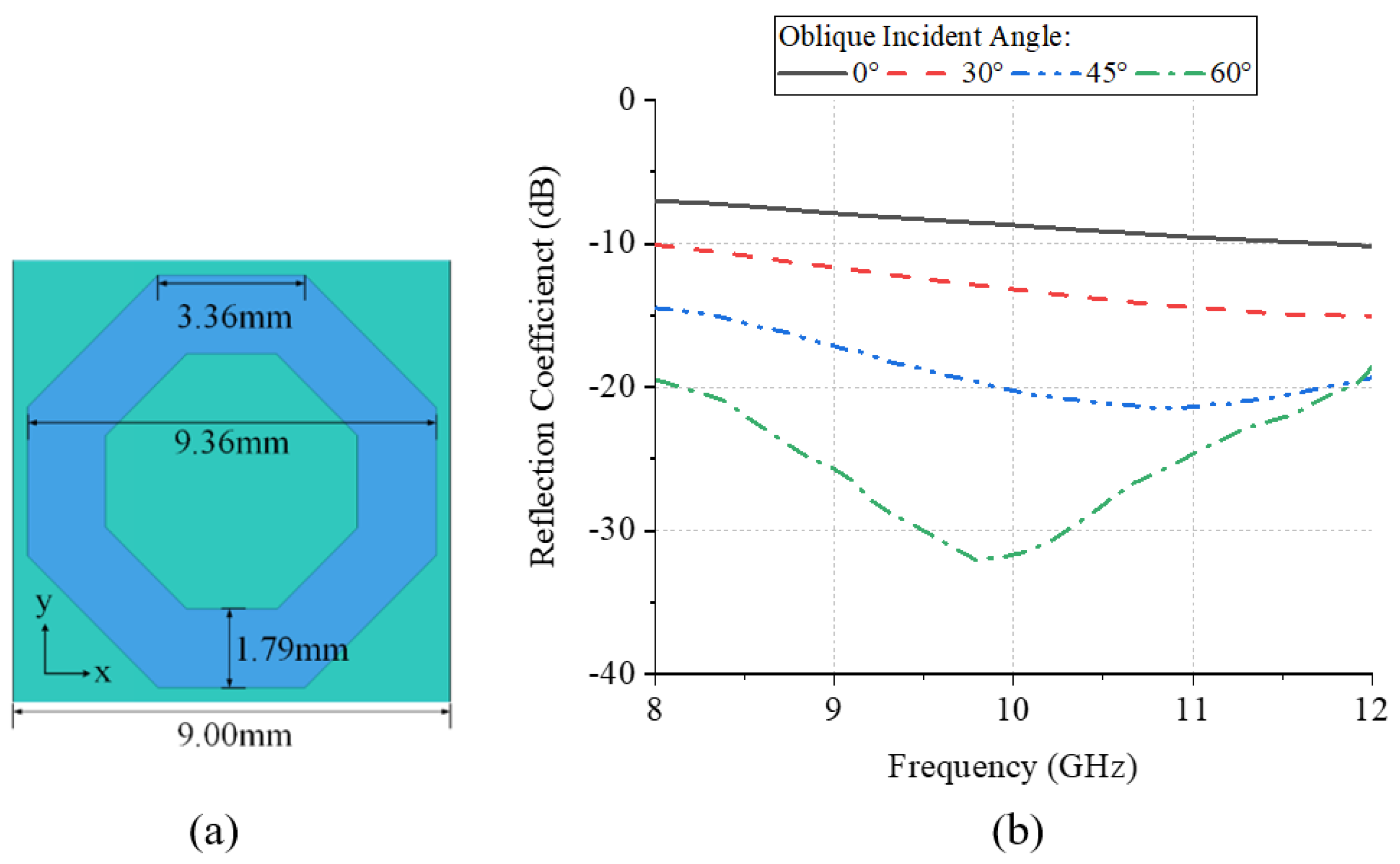
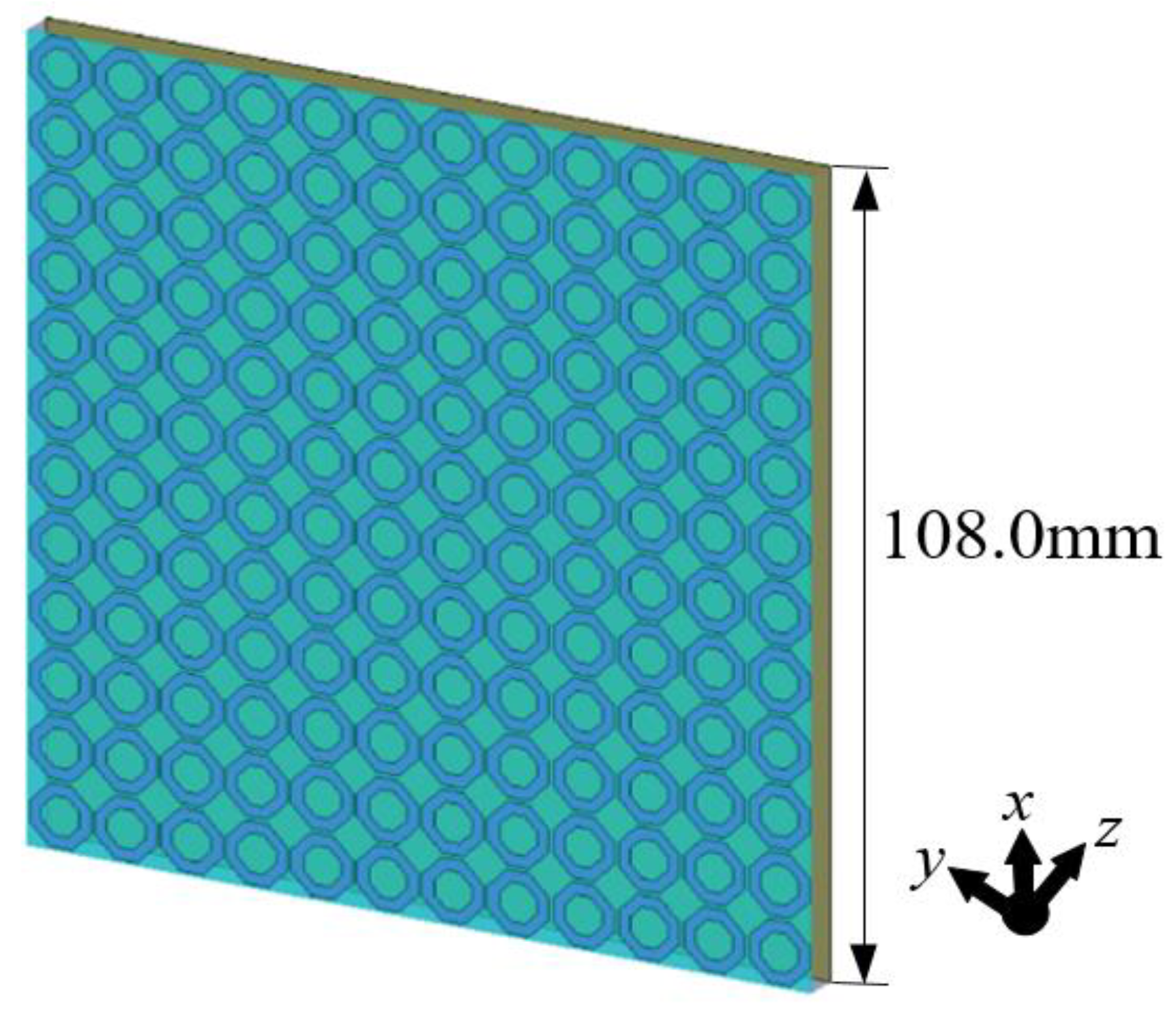
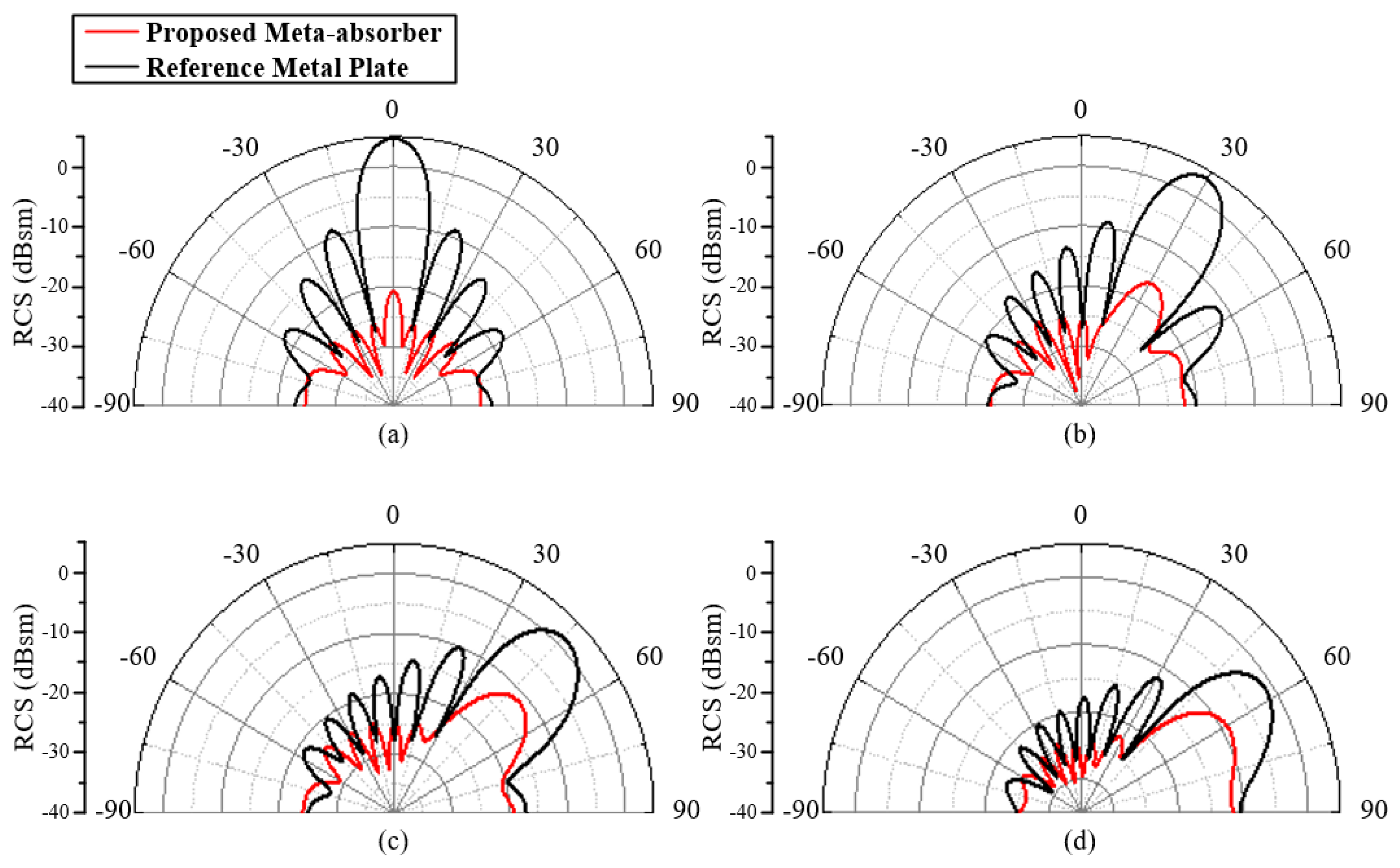


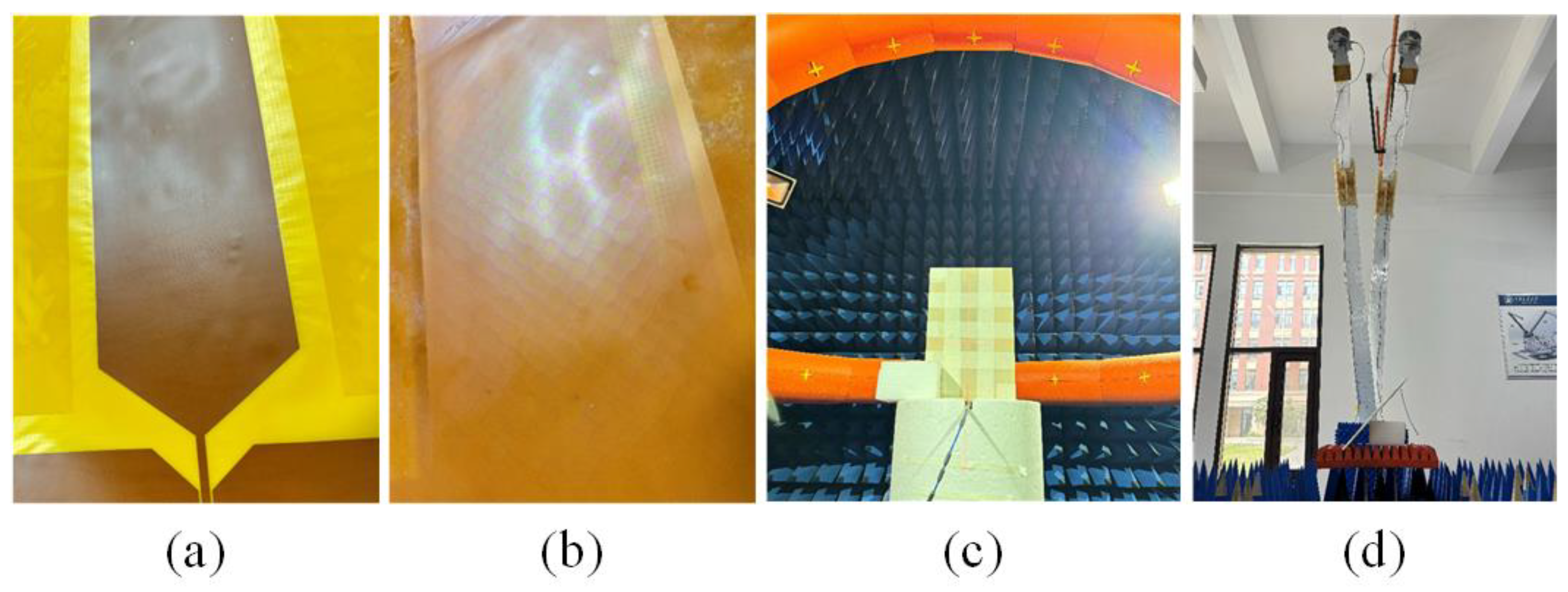
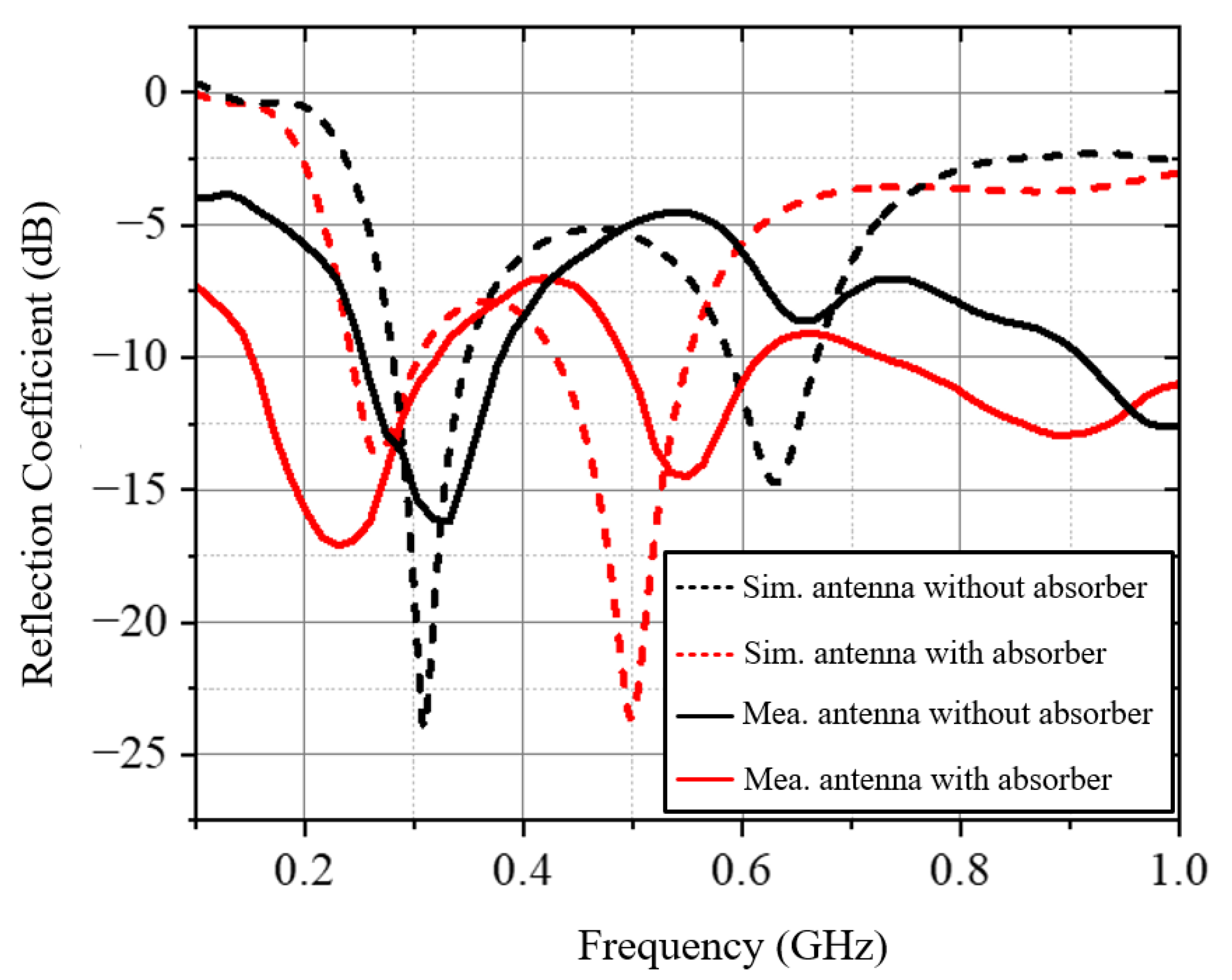
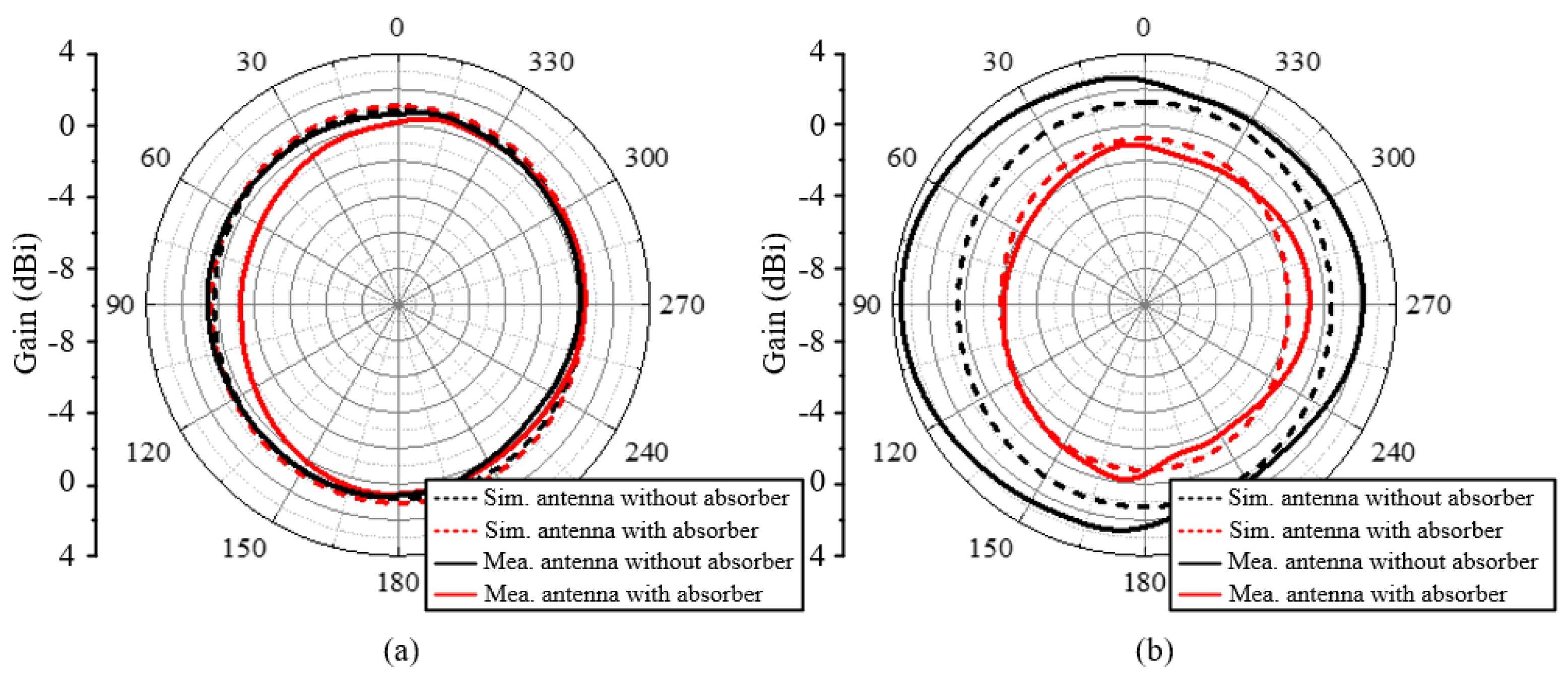
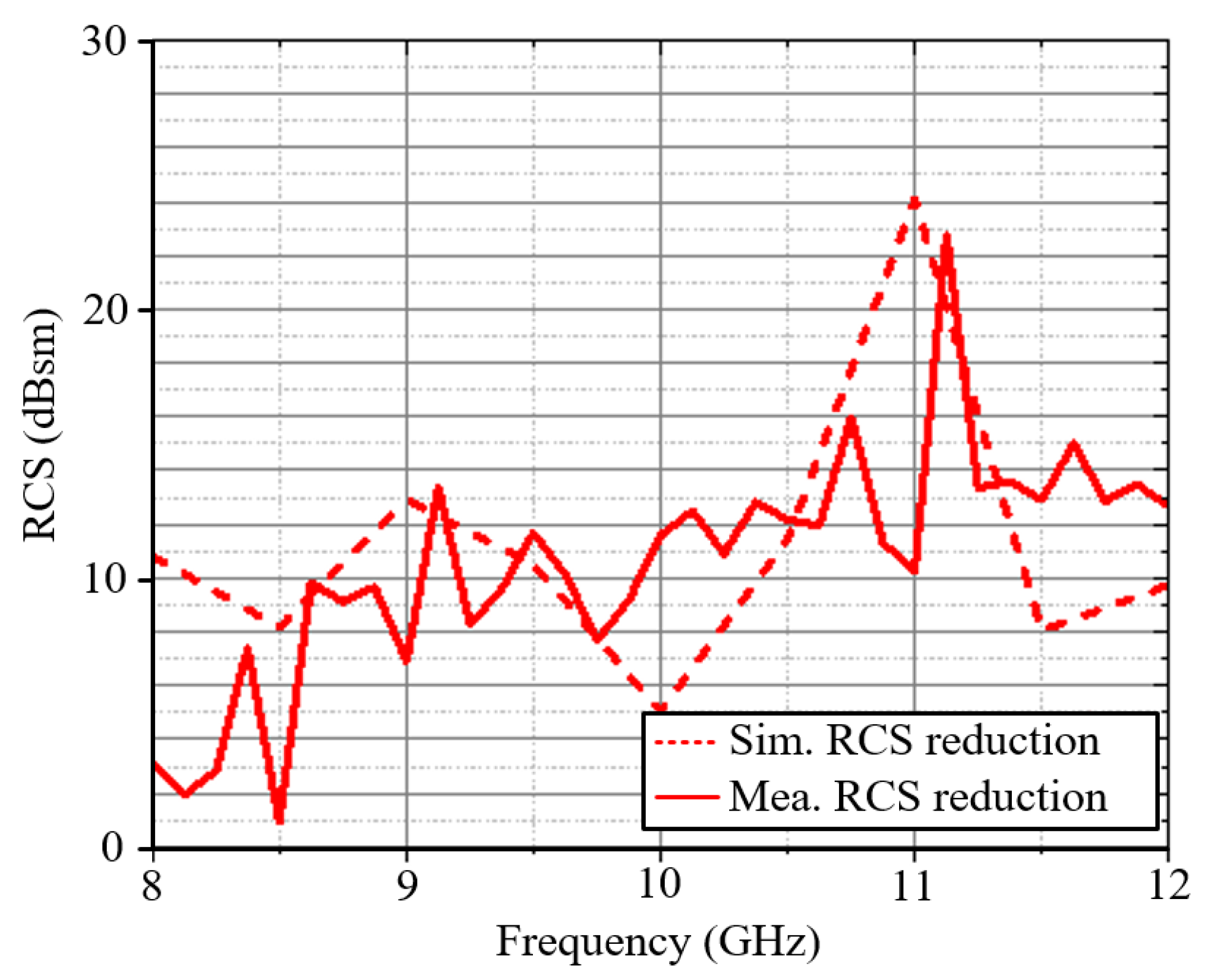
| Ref. | Flexibility | Polarization | Operating Bandwidth | Oblique Incidence Effective | Antenna Unit Size (λ0) | RCS Reduction |
|---|---|---|---|---|---|---|
| [21] 2023 | × | LP | 14.2–15.5 (87.5%) | × | 2.48 × 2.48 × 0.09 | 9.31–28.22 (>6 db) |
| [22] 2023 | × | LP | 4.8–6.0 (22%) | √ (Narrow) | 1.15 × 1.15 × 0.13 | 4.3–13.5 (>7 db) |
| [23] 2022 | × | LP | 9.5–10.15 (6.6%) | √ (Narrow) | 2 × 2 × 0.8 | 6–18 (>5 db) |
| This work | √ | LP | 0.19–0.74 (85.2%) | √ (Wide) | 0.822 × 0.434 × 0.09 | 8–12 (>10 db) |
Disclaimer/Publisher’s Note: The statements, opinions and data contained in all publications are solely those of the individual author(s) and contributor(s) and not of MDPI and/or the editor(s). MDPI and/or the editor(s) disclaim responsibility for any injury to people or property resulting from any ideas, methods, instructions or products referred to in the content. |
© 2025 by the authors. Licensee MDPI, Basel, Switzerland. This article is an open access article distributed under the terms and conditions of the Creative Commons Attribution (CC BY) license (https://creativecommons.org/licenses/by/4.0/).
Share and Cite
Lu, P.; Gong, J.; Liu, X.; Cao, Y.; Zhang, A.; Yan, S. ITO Meta-Absorber-Loaded Conformal UHF Monopole Antenna with Wide-Angel RCS Reduction. Materials 2025, 18, 1379. https://doi.org/10.3390/ma18061379
Lu P, Gong J, Liu X, Cao Y, Zhang A, Yan S. ITO Meta-Absorber-Loaded Conformal UHF Monopole Antenna with Wide-Angel RCS Reduction. Materials. 2025; 18(6):1379. https://doi.org/10.3390/ma18061379
Chicago/Turabian StyleLu, Pan, Jiuhao Gong, Xiaona Liu, Yuanxi Cao, Anxue Zhang, and Sen Yan. 2025. "ITO Meta-Absorber-Loaded Conformal UHF Monopole Antenna with Wide-Angel RCS Reduction" Materials 18, no. 6: 1379. https://doi.org/10.3390/ma18061379
APA StyleLu, P., Gong, J., Liu, X., Cao, Y., Zhang, A., & Yan, S. (2025). ITO Meta-Absorber-Loaded Conformal UHF Monopole Antenna with Wide-Angel RCS Reduction. Materials, 18(6), 1379. https://doi.org/10.3390/ma18061379








